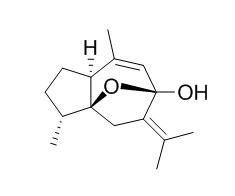4-Epi-curcumenol
Standard reference
Inquire / Order:
manager@chemfaces.com
Technical Inquiries:
service@chemfaces.com
Tel:
+86-27-84237783
Fax:
+86-27-84254680
Address:
1 Building, No. 83, CheCheng Rd., Wuhan Economic and Technological Development Zone, Wuhan, Hubei 430056, PRC
Providing storage is as stated on the product vial and the vial is kept tightly sealed, the product can be stored for up to
24 months(2-8C).
Wherever possible, you should prepare and use solutions on the same day. However, if you need to make up stock solutions in advance, we recommend that you store the solution as aliquots in tightly sealed vials at -20C. Generally, these will be useable for up to two weeks. Before use, and prior to opening the vial we recommend that you allow your product to equilibrate to room temperature for at least 1 hour.
Need more advice on solubility, usage and handling? Please email to: service@chemfaces.com
The packaging of the product may have turned upside down during transportation, resulting in the natural compounds adhering to the neck or cap of the vial. take the vial out of its packaging and gently shake to let the compounds fall to the bottom of the vial. for liquid products, centrifuge at 200-500 RPM to gather the liquid at the bottom of the vial. try to avoid loss or contamination during handling.
Evid Based Complement Alternat Med.2021, 8855980.
Institute of Food Science & Technology2021, 18 December.
Natural Product Sciences2024, 30(1):8-13.
Int J Mol Sci.2023, 24(17):13230.
Phytochem Anal.2023, pca.3305.
The Journal of Phytopharmacology2020, 9(1): 1-4
Indian J Pharm Sci.2022, 84(4): 874-882.
Phytomedicine.2021, 83:153483.
Institut Pasteur Korea2020, doi: 10.21203.
Universidade Estadual Paulista2017, 42785
Related and Featured Products
Heterocycles.2001 May; 55(5).
Inhibitors of Nitric Oxide Production and New Sesquiterpenes, 4-epi-Curcumenol, Neocurcumenol, Gajutsulactones A and B, and Zedoarolides A and B from Zedoariae Rhizoma.[Reference:
WebLink]
METHODS AND RESULTS:
Six new guaiane- or secoguaiane-type sesquiterpenes, 4-Epi-curcumenol, neocurcumenol, gajutsulactones A and B, and zedoarolides A and B, were isolated from aqueous acetone extract of Zedoariae Rhizoma (Zingiberaceae), together with 34 sesquiterpenes and two diarylheptanoids. The stereostructures of new sesquiterpenes were elucidated on the basis of chemical and physicochemical evidence, which included nuclear Overhauser effect (NOE) and circular dichroic (CD) spectroscopic analyses.
CONCLUSIONS:
Gajutsulactones A and B, and 14 sesquiterpenes, and two diarylheptanoids were found to inhibit nitric oxide (NO) production in lipopolysaccharide (LPS)-activated mouse peritoneal macrophages.



